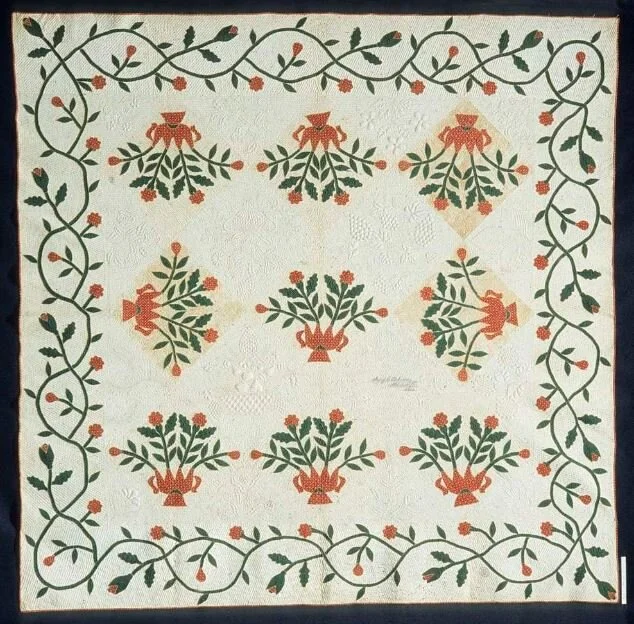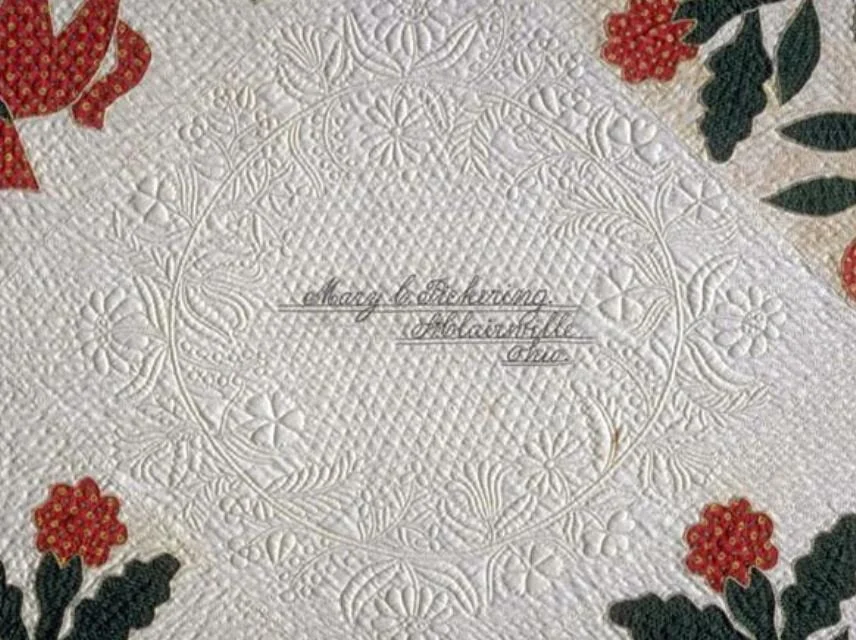The quilt historian Jonathan Holstein once stated that it was essential to examine quilts:
“They combine in single objects so much information important to us: the potent congruency of beauty, sentiment, history, utility…people were born and died under them, they cover our dreams.”[I]
Quilts have become significant objects of study for various disciplines, including folk history, feminism, and craft. Mary C. Pickering’s Quilt at the Smithsonian Museum of American History is a perfect example of a nineteenth-century discovering, whose meaning goes beyond mere utility. Examining the quilt provokes questions surrounding the production of the quilt, including the changing role of sewing, the relationship between process and design, and the boundaries between craft and art.
Before specifically analyzing the formal elements of Mary C. Pickering’s Quilt, let’s discuss the changing status of sewing during the nineteenth century. Unlike the eighteenth century, when quilting was an essential part of the household economy, the nineteenth century brought the dawn of the machine age[ii], when factory-made textiles became cheap and accessible.[iii] As one historian describes it: “By the late nineteenth century, the needle was no longer a woman’s constant companion.” [iv]
However, it is important to remember that while there was a declining interest in quiltmaking in urban areas of the United States, women in rural areas continued to uphold the quiltmaking traditions[v] like Clairsville, Ohio where Mary Pickering resided. Even in rural areas, the social meaning of quilts had changed. While quilted bedcoverings continued to have a dual function as both decoration and protection, [vi] emphasis was increasingly placed on the decorative aspects. Quiltmaking became less of a necessary domestic chore and more of an appropriate pastime for women.[vii]
The design of the quilt rather than the practicality of it (i.e., the quilt’s ability to insulate) became the primary focus. Such shifts in the object’s function partly explain why the nineteenth-century quilt increasingly became a symbolic marker[viii], often commemorating a particular event used, such as an upcoming wedding through the motifs.
In other instances, quilting could also have a psychological function. It may bring solace to the maker during times of anxiety[ix] as in the case of Mary C. Pickering’s Quilt, made during the years Mary Pickering waited for her future husband John Bell to return from the Oregon Territory.
Although some the museum label provides some information about the personal context surrounding the quilt, it does not give details regarding the construction of the object. A further examination of the formal elements is required to understand better the process involved in making the quilt and its direct impact on the design.
The basic technique of quilting has changed little over the centuries. Two layers of fabric are stitched together with a filler in between the two materials.[x] In Mary C. Pickering’s Quilt, the quilt has been assembled with nine blocks of fabric arranged in diagonal lines and framed by vertical and horizontal lines.
Appliqué involves taking the quilting process a step further. Ornamentation is added sewing cut out designs onto the main fabric. In Mary C. Pickering’s Quilt, the white cotton background greatly contrasts with the added red and green appliquéd pieces whose motifs include nine flower baskets and a flowering vine around the frame. There are several ways to sew these cut-out pieces onto the background fabric: using a seed, an overcasting stitch, or edges are turned under to create a hem before stitching.[xi]
In America during the nineteenth century, the technique of the appliqué technique was as popular as the patchwork method. Yet, appliqué required more skill since the quilt-maker did not sew in simple, straight lines[xii] but rather in curves. The curvilinear forms of the stylized leaves found on the stems and vines demonstrate this skill.
A less obvious area of detailed sewing in Mary C. Pickering’s Quilt occurs on the “white-on-white” quilts in which decoration is created solely by the sewing stitches that produce a raised pattern[xiii] of grapes, flowers, or wreaths.
As with all textiles, the process of making is intrinsic to the outcome of the design. For quilts, evidence of stitching is visible on the finished product. Thus, sewing is not only a manual process but also an artistic skill in which the “maker’s mark” is revealed in the details similar to a painter’s brush marks on a canvas.
Historians have noted the idea of a quilt as a form of canvas. It brings up the never-ending question about the boundaries between fine art and craft. Indeed, quiltmaking has been traditionally viewed as a craft for two main reasons: (1) the quilt has a utilitarian function, and (2) quilts have been made by women.[xiv]
Despite the practical uses of quilts, it is interesting to note that the similarities between quilts and paintings, both of which involve a sophisticated understanding of shape, color, pattern, and composition to be aesthetically successful. Also, like paintings, there is a sense of “flatness” to appliquéd quilts since the cut-out designs are often two-dimensional, as demonstrated by the abstracted flower forms created by Mary C. Pickering.
In Mary C. Pickering’s Quilt, the addition of the text reinforces similarities between a quilt and a painting: Mary Pickering, St. Clairsville Ohio. The inscription is stitched in black silk in a prominent area of a white block near the center of the quilt’s composition.
Such inclusion of name and place parallels an artist’s signature on a painting. The fact that Mary Pickering included her name on the quilt indicates her pride in workmanship and her desire to be acknowledged for her artistic accomplishment. Also, the family anecdote that Mary Pickering won a blue ribbon for her quilt at a local fair furthers the argument that quiltmaking was beginning to be recognized in the nineteenth century as a craft that required artistry.
Like many textile traditions, quilting has often been marginalized because of its association with “women’s work”[xv]. Yet, recent feminist historians have begun to praise quilts as “The Great American Art” since women of different regions, race, gender, and class participated in the tradition.[xvi] Thus, similar to the way that quilt-makers like Mary C. Pickering fuse beauty and utility, they also blend craft and fine art creating an object whose aesthetic meaning cannot go unnoticed.
Quilts not only “cover over our dreams,” as Holstein says, but they also encompass American life: from society’s industrialization to a more personal expression of self. Similar to the way that different fabrics stitched together to create a cohesive whole, historians must also piece together the historical, aesthetic, and social factors.
The personal meaning of Mary C. Pickering’s Quilt will remain a mystery to the twenty-first-century observer. However, we can begin to understand the cultural significance of surviving nineteenth-century quilts in terms of design, gender, and folk craft.
Enjoyed reading? Subscribe to our newsletter.
© Courtney Ahlstrom Christy 2014
Ahlstrom Appraisals | Personal Property Appraisals and Art Consultations | Serving Atlanta & Southeast | Fine Art, Antiques & Design
Sources
[i] Jonathan Holstein, Abstract Design in American Quilts: A biography of an Exhibition (1991): 130, quoted in Carolyn Senft, “Cultural Artifact and Architectural Form: A Museum of Quilts and Quilt Making,” Journal of Architectural Education 48 (1995): 144.
[ii] New Jersey Quilters: A Timeless Tradition. Edited by Nan Helene Mutnick with Morris Museum of Art and Sciences, 1983. An exhibition catalog, 5.
[iii] It is important to remind oneself that these factory-made textiles were also made by women yet in a very different industrial environment in comparison to the previous domestic setting.
[iv] Pat Kirkham, ed. Women Designer in the USA 1900-2000 Diversity and Difference (New Haven: Yale University Press, 2000), 168.
[v] Pat Kirkham, ed. Women Designer in the USA 1900-2000 Diversity and Difference (New Haven: Yale University Press, 2000), 168.
[vi] Jonathan Holstein, American Pieced Quilts (New York: The Viking Press, 1972), 7.
[vii] New Jersey Quilters: A Timeless Tradition. Edited by Nan Helene Mutnick with Morris Museum of Art and Sciences, 1983. An exhibition catalog, 5.
[viii] Pat Ferrero and Elaine Hedges. Hearts and Hands: The Influence of Women and Quilts on American Society, (San Fransisco: The Quilt Digest Press, 1987), 28.
[ix] Daryl M. Hafter, “Toward a Social History of Needlework Artists.” Woman’s Art Journal 2 (1982): 26.
[x] Jonathan Holstein, American Pieced Quilts (New York: The Viking Press, 1972), 7.
[xi] Carleton L. Safford and Robert Bishop. America’s Quilts and Coverlets (New York: Weathervane Books, 1972), 145.
[xii] Carleton L. Safford and Robert Bishop, America’s Quilts and Coverlets (New York: Weathervane Books, 1972), 145.
[xiii] Jonathan Holstein, American Pieced Quilts (New York: The Viking Press, 1972), 8.
[xiv] Women’s production of decorative goods was traditionally been placed under craft especially during the nineteenth century.
[xv] Pat Kirkham, ed. Women Designer in the USA 1900-2000 Diversity and Difference (New Haven: Yale University Press, 2000), 167.
[xvi] Pat Kirkham, ed. Women Designer in the USA 1900-2000 Diversity and Difference (New Haven: Yale University Press, 2000), 168.


